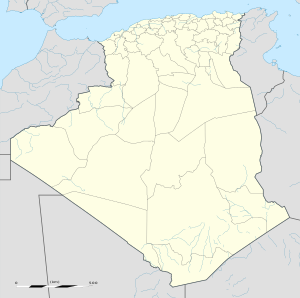Adrar, Algeria
| Adrar | |
|---|---|
| City | |

Buildings in Adrar
|
|
 Location of Adrar commune within Adrar Province |
|
| Location of Adrar within Algeria | |
| Coordinates: 27°52′N 0°17′W / 27.867°N 0.283°WCoordinates: 27°52′N 0°17′W / 27.867°N 0.283°W | |
| Country |
|
| Province | Adrar Province |
| District | Adrar District |
| Area | |
| • Total | 633 km2 (244 sq mi) |
| Elevation | 258 m (846 ft) |
| Population (2008) | |
| • Total | 64,781 |
| • Density | 100/km2 (270/sq mi) |
| Time zone | CET (UTC+1) |
| Area code(s) | 0101 |
| Climate | BWh |
Adrar (Berber: Adrar, ⴰⴷⵔⴰⵔ; Arabic: أدرار) is the administrative capital of Adrar Province, the second largest province in Algeria. The commune is sited around an oasis in the Tuat region of the Sahara Desert. According to a 2008 census it has a population of 64,781, up from 43,903 in 1998, with an annual growth rate of 4.0%.
Adrar is mainly an agricultural town, characterized by its traditional irrigation system, the Foggara.
Adrar lies at an elevation of 258 metres (846 ft) above sea level. A large oasis lies to the southwest of the town; this oasis lies in the Tuat region, a string of oases running from Bouda in the north to Reggane in the south. A vast area of sand dunes, the Erg Chech, lies to the west, while a large rocky plateau, the Tademaït, lies to the east.
Adrar was the site of one of the In Ekker series, French nuclear tests during the 1960s.
Adrar has a hot desert climate (Köppen climate classification BWh), with long, hot summers and short, warm winters, and averages just 15 millimetres (0.59 in) of rainfall per year. Summer temperatures are consistently high as they commonly approach 40 °C (106 °F). temperatures at night are still hot at around 27 °C (81 °F). Even in early May or in late September, daytime temperatures can to 45 °C (113 °F). Adrar experiences the same kind of desert heat as Death Valley, California during summertime. Winter nights can be chilly and frost is by no means unknown but the days are pleasantly warm, sunny and dry. During the summer, the Sahara region of Algeria is the source of a scorching, sometimes dusty and southerly wind called the Sirocco. These winds parch the plateaus of northern Algeria up to 40 days and reach the Tell coastal region for as many as 20 days.
...
Wikipedia

